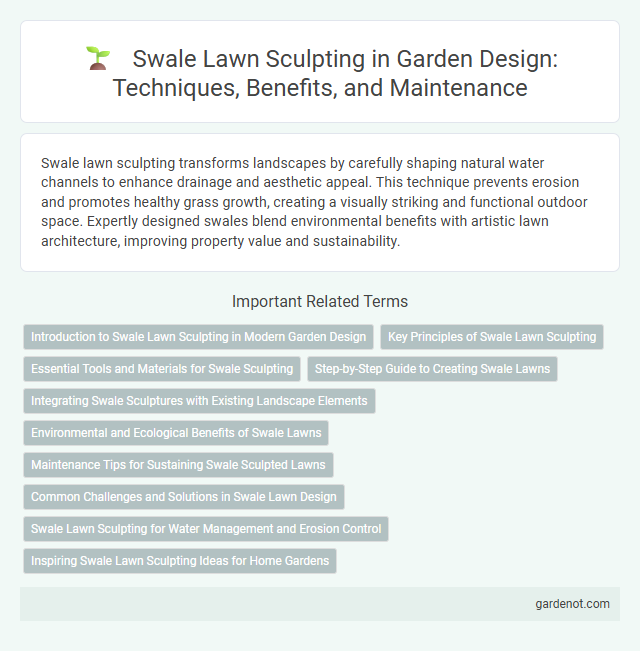Swale lawn sculpting transforms landscapes by carefully shaping natural water channels to enhance drainage and aesthetic appeal. This technique prevents erosion and promotes healthy grass growth, creating a visually striking and functional outdoor space. Expertly designed swales blend environmental benefits with artistic lawn architecture, improving property value and sustainability.
Introduction to Swale Lawn Sculpting in Modern Garden Design
Swale lawn sculpting integrates water management and aesthetic appeal by creating shallow, curved depressions that direct rainwater efficiently. This technique enhances soil moisture retention and supports sustainable landscaping in modern garden design. Gardeners leverage swales to blend functionality with natural beauty, promoting healthier plant growth while reducing erosion.
Key Principles of Swale Lawn Sculpting
Swale lawn sculpting centers on key principles such as effective water management, enhanced soil erosion control, and landscape contouring to maximize natural drainage pathways. Strategic swale placement following the land's natural topography ensures optimal rainwater infiltration and minimizes runoff, promoting sustainable irrigation. Incorporating native vegetation within swales further stabilizes soil and fosters biodiversity, enhancing overall ecosystem resilience.
Essential Tools and Materials for Swale Sculpting
Swale lawn sculpting requires essential tools such as a shovel for digging precise contours, a mattock for breaking hard soil, and a tamper to compact the earth firmly. Quality materials include landscape fabric to prevent weed growth, topsoil rich in organic matter for healthy plant growth, and mulch to retain moisture and enhance aesthetics. Proper selection and use of these tools and materials ensure the swale functions effectively in water management and landscape design.
Step-by-Step Guide to Creating Swale Lawns
Creating swale lawns involves precise earth shaping to manage water flow and improve drainage. Begin by mapping the slope and marking swale locations, then excavate shallow, curved depressions following the natural contours of the land. Finish by compacting the soil edges, planting drought-tolerant grass or ground cover, and installing an optional mulch layer to enhance water retention and prevent erosion.
Integrating Swale Sculptures with Existing Landscape Elements
Swale lawn sculpting enhances water management by seamlessly integrating sculpted depressions with natural landscape elements such as trees, shrubs, and garden beds. These strategically contoured swales slow runoff, promote infiltration, and complement existing vegetation, improving soil moisture and reducing erosion. Incorporating native plants within swale designs strengthens ecosystem resilience while maintaining aesthetic harmony in the landscape.
Environmental and Ecological Benefits of Swale Lawns
Swale lawn sculpting enhances natural water management by directing runoff toward vegetation-rich depressions, reducing soil erosion and promoting groundwater recharge. These sculpted landscapes increase biodiversity by creating habitats for native plants, insects, and pollinators, supporting overall ecosystem health. Swales also improve urban heat island mitigation through increased soil moisture retention and vegetative cover, contributing to cooler, more resilient environments.
Maintenance Tips for Sustaining Swale Sculpted Lawns
Maintaining swale sculpted lawns requires consistent watering to prevent soil erosion and encourage healthy grass growth within the contours. Regular mowing and trimming around the swale edges preserve the defined shapes while preventing overgrowth that can obscure the design. Incorporating organic mulch and periodic aeration enhances soil structure, promoting water absorption and root development critical for sustaining the lawn's sculpted form.
Common Challenges and Solutions in Swale Lawn Design
Swale lawn sculpting often faces challenges such as improper drainage, soil erosion, and uneven grading, which can lead to water pooling and damage to the lawn's health. Effective solutions include installing proper drainage systems like French drains, using erosion control blankets or native vegetation to stabilize soil, and meticulously grading the swale to ensure smooth water flow. Regular maintenance and adjusting the swale's contour during planting phases help prevent common issues and sustain the lawn's functionality and aesthetic appeal.
Swale Lawn Sculpting for Water Management and Erosion Control
Swale lawn sculpting effectively channels rainwater to prevent soil erosion and enhance groundwater recharge. By creating shallow, vegetated trenches, swales slow runoff, reducing surface water accumulation and promoting infiltration. This natural water management technique supports sustainable landscaping and mitigates flood risks.
Inspiring Swale Lawn Sculpting Ideas for Home Gardens
Swale lawn sculpting transforms home gardens with natural drainage solutions that blend aesthetics and functionality, enhancing soil retention and reducing erosion. Incorporating curved swales around flower beds or vegetable patches creates visually dynamic landscapes while promoting water conservation. Ideas like tiered swales or integrating native plants boost biodiversity and add textural interest to garden spaces.
Swale lawn sculpting Infographic

 gardenot.com
gardenot.com